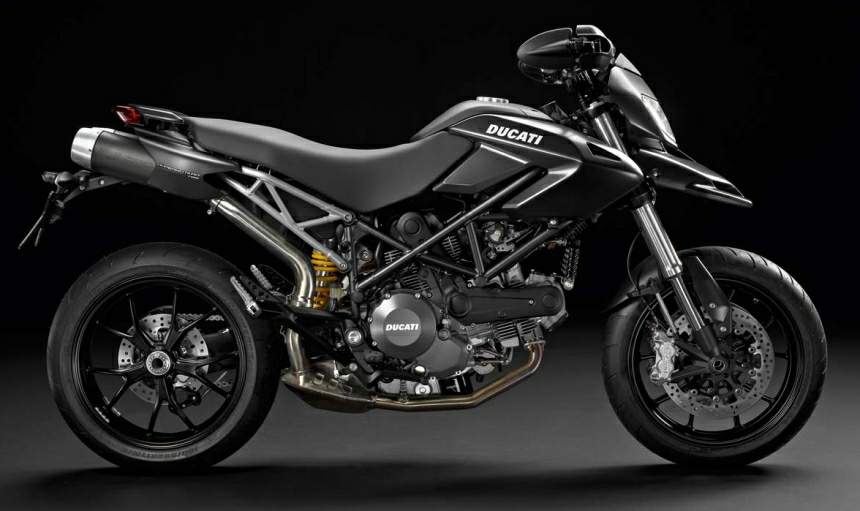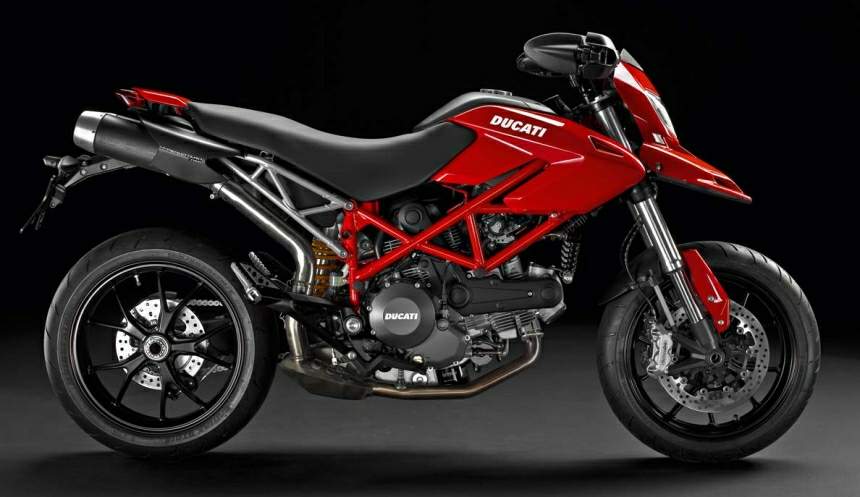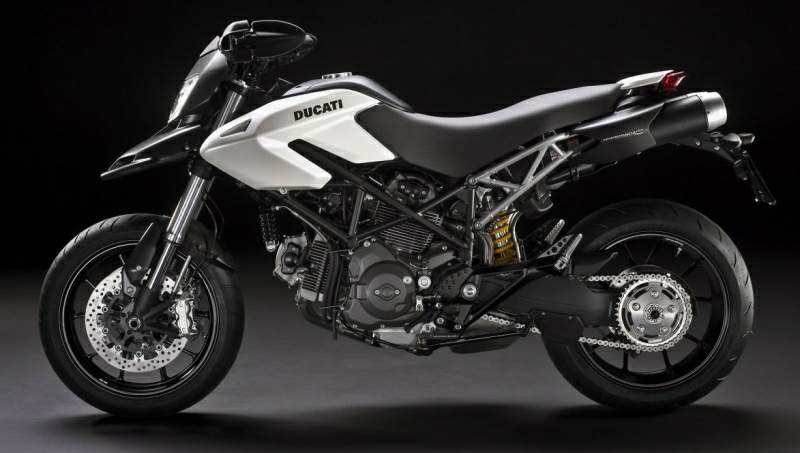2010 Ducati Hypermotard 796
The new way to go Hyper
The Hypermotard family expands for 2010 with the addition of the exciting new Hypermotard 796. Just as aggressively striking as the 1100, the new Hypermotard 796 features a lower seat height and brand new smooth and flexible engine to make it the perfect urban assault vehicle. Whether it's working the daily commute or attacking the open roads, the 796 rides the common ground between manners and madness by mixing Ducati's unrivalled twin-cylinder power and sportbike heredity with the lightweight and minimalist supermotard concept.
Hours after its first showing at the 2005 Milan International Motorcycle show, the Hypermotard was awarded "Best of Show" and became an instant hit in Italy, where motorcycles are as much a lifestyle choice as they are transportation. Since then, its out-of-the-ordinary design went on to win converts around the world and the praise and admiration for this unique bike has never stopped - and neither has its development. The thrilling, street-wise Hypermotard range with L-Twin acceleration and pavement-attacking style is now extended with the hyper-agile 796 - the new way to go Hyper.
Urban upstart
The Hypermotard's rigidly triangulated and now lighter than ever Trellis frame and track-tested chassis geometry is still stylised by a distinct high fender at the front and dual under-seat silencers at the rear, but the new 796's overall profile says it all: Go Hyper!
At 825mm (32.5in), the seat height of the 796 is a sure-footed 20mm (0.8in) lower than the 1100 and, when combined with the new engine's smooth power delivery, this Hypermotard inspires confidence however and wherever its ridden. The upright seating position offers a commanding view of the road ahead, while the wide handlebars make the bike effortlessly flickable through the urban maze.
The 796 weighs in at just 167kg (368lb), partly achieved by a lightweight engine, but also by continued chassis development that includes redesigned top and bottom fork clamps and an improved frame layout which eliminates almost all of the forged elements previously used with the 1100. The lightened frame retains its torsional strength to become even more agile and easier to handle than before, while 17" wheels by Enkei are produced in lightweight aluminium to keep the unsprung weight low and handling, braking and acceleration performances high. The same 3.50 front and 5.50 rear rim sizes as the 1100 are used with Bridgestone tyres.
Suspension duties up front are taken care of by a pair of very capable 43mm Marzocchi forks, while the rear is managed by a Sachs suspension unit featuring adjustable spring preload and return damping, allowing adjustments for riding style or load. The rear operates through a similar progressive link to the 1100 and uses the signature Hypermotard single-sided swingarm.
Twin 305mm semi-floating discs gripped by radially mounted 4-piston Brembo callipers provide powerful and progressive front-end braking with that all-important rider-friendly 'feeling', while the rear is equipped with a 245mm disc and 2-piston calliper, also by Brembo.
A brand new Ducati engine
The 796 engine isn't just a 'stroked' 696 - it's a completely brand new Desmodue power unit. A new crankshaft designed around lightweight 848-type flywheels, spin with a 66mm stroke instead of the 696's 57.2mm, helping to maximise power to an impressive 81hp (59.6kW) @ 8000rpm and torque to 55.7lb-ft (75.5Nm) @ 6250rpm while maintaining the smooth and enjoyable character, famous of all Desmodromic L-Twins. To protect power delivery and maintain optimum efficiency, an oil cooler similar to the 1100 is used, adding even more family resemblance to its bigger brother.
Helping to increase the Hypermotard 796's agility even further, the fully redesigned crankcases save an incredible 1.2kg (2.64lb) over the 696 castings, and are responsible for the major part of the impressive 1.9kg (4.2lb) total saving over the 696 power unit. The clutch and alternator outer casings of the new engine are finished in an 1100-style carbon grey.

Breathing through a newly-revised airbox intake duct and fed through 45mm throttle bodies, the 803cc swept volume is compressed to a ratio of 11:1 - compared to the 696's 10.7:1 - before being injected and ignited with Siemens controlled electronics. The 2-1-2 catalytic exhaust system uses an efficient pre-silencer configuration with twin lambda probes providing finer fuel mapping and Euro 3 conformity. The system's lightweight and compact design is achieved by using 1mm thick tubing and terminates in Ducati's trademark twin under-seat, black exhaust mufflers, stylishly contrasted with great looking aluminium end caps .
An APTC 'wet' clutch gives a 'slipper' type action that prevents destabilizing of the rear-end under aggressive down-shifting and also gives the extra benefit of a super-light feel at the lever, a great benefit in stop-start city traffic or during longer journeys. The 21-plate oil-bath clutch (11 friction and 10 steel) represents a power-enhancing weight reduction over the 'dry' system as well as having a quieter operation and requiring less maintenance.
The new Hypermotard 796 engine combines all recent advances in Ducati's ongoing design, manufacture and production quality campaigns to offer competitive service intervals of 12,000 kilometres (or 7,500 miles).
Controls and instrumentation
While its motard feeling is enhanced by wide bars and handguards, the 796's minimalist image is further characterised with the orange back-lit Streetfighter-style digital instrumentation and switchgear.
The slim-line switch bodies house easy-to-use switches and buttons and feature a unique weapons-like 'trigger catch' that slides down to cover the starter button when the kill-switch is activated. Looking clean and purposeful, the display provides an extensive amount of data including: speed, revs, time, maintenance schedule, oil temperature, oil pressure warning light, battery voltage, fuel reserve warning light, reserve fuel trip, turn indicator light, neutral light, lap time memory storage, automatic light-off function after 60 seconds with the key on and immobiliser status. In addition, it can list lap times recorded by using the high-beam flash button as a stopwatch.
The instrument display also doubles as a control panel for the activation of the Ducati Data Analyser (DDA) system, which is available as an accessory from Ducati Performance. The 796 has been built 'system-ready' for the data acquisition kit, which consists of a special DDA software and memory key that slots into a plug under the seat. The same plug also doubles as the connection for a handy new battery charger available as an accessory from Ducati Performance.
Integral construction Brembo master cylinders are used for both the clutch and brake systems and maintain a clean handlebar arrangement for the rider. They are fitted with user-friendly 4-point adjustable levers that provide easy-to-reach control for all hand sizes and the APTC clutch offers a super-light lever action ideal for use in the city.

Hyper mirrors
Ducati pushed motorcycle design limits to find an innovative solution for the Hypermotard 1100 mirrors and this has been maintained on the new 796. The challenge of maintaining a clean, racing look around the handlebar area, motivated the design of the folding mirror concept which is based on the handguards typically found on off-road bikes. Flipped out for high visibility street mode and easily folded in for a quick change to 'Hypermode', the mirror handguard assemblies also integrate the LED directional indicators for an even cleaner front-end.
Lighting and indicators
The headlamp uses a highly compact lighting shape which blends with the single piece nose fairing and front fender moulding, while the rear light employs a specially designed strip of LEDs enhanced by a high diffusion lens shaped into the sleek lines of the tailpiece. The same LEDs are intensified under braking. The front directional indicators also employ the latest in LED technology for illumination, and are ingeniously integrated into the handguards which support the foldable rear view mirrors.
Tailpiece
The high intensity LED rear light assembly is moulded into a unique tailpiece positioned high behind the seat. The supporting structure has been designed so that the under tray of the tailpiece is formed perfectly to offer a sturdy pair of pillion grab-handles. This ingenious solution not only helps to merge the rear light into the Hypermotard styling but also provides a safe grip for the passenger.
796 in three colours
The new 796 comes in an urban-style Dark finish with matte black tank and beak section, black frame and black wheels or, alternatively, matte white tank with contrasting matte black beak, black frame and black wheels. For the purists, an 1100 look-alike red tank with matching beak section, red frame and black wheels keeps the 796 in traditional livery.
The Hypermotard story
When the prototype Hypermotard was first shown at the Milan show it represented the creation of a new segment, one that bridged the gap between refined sportbikes and minimalist supermotards. But some at Ducati had reservations about the initial Hypermotard concept and were unsure whether or not the market was ready for such a motorcycle.
Despite those reservations, the project continued to be developed, driven by the belief in the upright and in-control riding position of a dirtbike, but not the harsh characteristics of its single cylinder engine. These confident few liked the feel of a skinny, taut and agile chassis, but not the fact that its original off-road design made it a compromise on the street. They set about creating a bike that combined the agility and lightweight precision of a supermotard, with the refined power characteristics of a charismatic L-Twin Ducati sportbike. They were designing the future.
As each day went past, more and more people in the factory got to hear about the completed bike and those who had the chance to catch sight of it all responded in the same way: "Wow! We're going to produce it, right?" There was one way to gauge market response: show it at the 2005 Milan show as a prototype and conduct an online survey.
Ducati presented the prototype Hypermotard as its centrepiece that year and their confidence was rewarded with a global 'yes!' from the public, the 'Best of Show' award, and demands from riders all over the world to produce it immediately. In fact, a staggering 15,000 people completed the Ducati.com survey, with more than 50% asking for the Hypermotard to be built exactly as shown at the show. But Ducati were serious when they asked the public for their feed-back and took time to sift through thousands of additional suggestions and requests, such as twin front brake discs instead of the prototype's single, and integrated many of them into the final production design.
The innovative Hypermotard spawned a new and exciting 'cross-over' category that had reinvented pure riding pleasure with a practical and versatile motorcycle that could be used every day. Riders hungry for excitement immediately understood the concept and have been enjoying it ever since.

Quick glance history
November 2005: Prototype Hypermotard 1100 shown at Milan International Motorcycle Show. Awarded 'Best of Show'.
November 2006: Production Hypermotard 1100 and 1100 S launched at Milan International Motorcycle show.
May 2007: Hypermotard 1100 and 1100 S were launched to the press and at the same time arrived in showrooms as an early release model year 2008.
November 2008: Model year 2009 Hypermotard 1100 updated with an additional colour option of pearl white. Hypermotard 1100 S with an additional colour option of black and DDA kit supplied as standard equipment. The Hypermotard 1100 S takes victory at Pike's Peak International Hill Climb, Colorado (1200cc category).
October 2009: "Hypermotard" family expands with the release of new model year 2010 Hypermotard 796.
Source: https://www.motorcyclespecs.co.za/model/ducati/ducati_hypermotard_796%2010.htm

0 Komentar